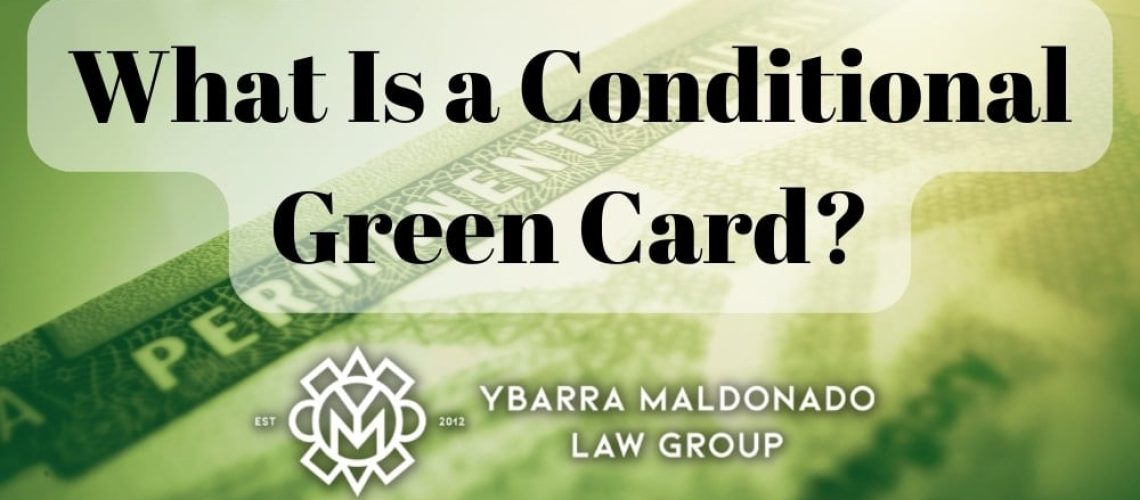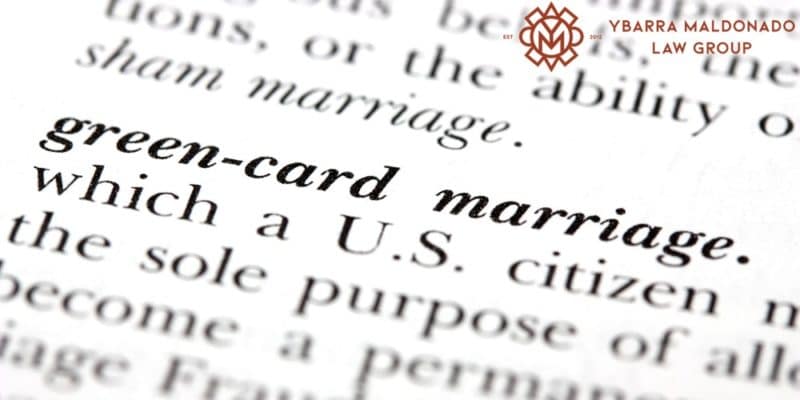Did you know that there are multiple types of green cards that someone can get when they obtain a marriage-based green card? Depending on how long someone has been married by the time their visa is approved, they will receive either a conditional green card or a permanent green card. Luckily, if you receive conditional permanent resident status, there are steps you can take to obtain permanent resident status.
At Ybarra Maldonado Law Group, our Phoenix immigration attorneys have extensive experience helping immigrants and their family members achieve permanent residency status. If you’re aiming to become a permanent green card holder, but you currently have a conditional green card, we’re here to help. Contact our law firm at 602-910-4040 today to schedule your consultation with one of our qualified green card lawyers.
What Is a Conditional Green Card?
Conditional green card holders can live and work in the United States just like a permanent resident, except the conditional green card expires after two years. Before this two-year period is up, the conditional green card holder must adjust their status to get a permanent green card. When people apply for marriage-based green cards, they will receive a permanent resident green card if they have been married for more than two years. If not, this is when they will receive a conditional permanent resident card.
Can I Renew My Conditional Green Card?
No. A conditional green card cannot be renewed. Rather, conditional green card holders must update their status to obtain a full 10-year green card. Generally, a conditional resident must update their status during the 90-day window before their conditional green card expires. If they fail to do this, they will lose their permanent residency status and have to leave the United States. In order to obtain permanent residency, they will need to prove once more that their marriage is bona fide, or real.
Can I Travel with a Conditional Green Card?
Unfortunately, anytime that a conditional resident or permanent resident leaves the country for travel, they accept a certain degree of risk. Those with both conditional residency and permanent residency have the right to travel outside the country and then return afterward. However, there are certain limitations to this right under the current immigration laws.
- If you have been deemed “inadmissible” before your return, you could be barred from reentry to the United States.
- If you spend too much time outside the country, or if you give up your home, you could be considered to have abandoned your United States residence.
- Maybe you have a marriage-based green card. If you spend a long time outside the United States while your spouse stays behind, this could make it difficult to prove that you have a bona fide marriage. In order to adjust from conditional residence to permanent residence, you’ll need to show the validity of your marriage. Spending too much time apart could make this very challenging.
Why Would Someone Have Conditional Citizenship?
The most common reason why someone might have conditional resident status is because they have immigrated to the United States as the spouse of a citizen before the second anniversary of their marriage. Any children involved may also have conditional permanent residence. Additionally, the EB5 investor visa grants conditional permanent residency, although this is a much rarer situation. Both situations require the conditional green card holder to petition to remove conditions on their cards in the 90 days that precede their second year of having conditional permanent residency.
Conditional Residents vs Permanent Residents
Contrary to what many people believe, conditional green cards are not very different from permanent green cards. Being a conditional permanent resident does not mean that you’re not a citizen of the United States. In fact, a conditional permanent resident receives the same rights as lawful permanent residents. They just have extra steps to take before they can become a permanent resident. Both conditional and permanent resident statuses afford the same rights to the green card holders.
Those with conditional green cards have all the same rights as permanent residents. This means they have no green card restrictions and no travel restrictions. You’ll simply need to petition to remove conditions on your green card before the expiration date rolls around.
How Do I Remove Conditions from My Conditional Green Card?
This largely depends on why you have a conditional green card. If you obtained a conditional marriage green card, you will need to file Form I-751, Petition to Remove the Conditions of Residence. If you obtained a conditional EB5 investor visa, you will need to file Form I-829. In either case, you will need to file these forms with the United States Citizenship and Immigration Services.
What Is Removal of Conditions?
Adjustment of status or removal of conditions is the legal process through which someone with a temporary green card obtains a permanent green card. In the most common cases, a foreign national obtains a marriage visa through their citizen spouse. However, if they have been married for under 10 years, they receive a conditional green card. Before the two-year deadline arrives, they must submit certain forms to USCIS to adjust their immigration status. In the following sections, we outline the two major ways to obtain permanent residence status.
How to Apply for Removal of Conditions
Depending on the circumstances of your case, you will either file Form I-751 or Form I-829. We explain these processes below.
What Is Form I-751?
Form I-751, also called the Petition to Remove Conditions on Residence, is used to turn a conditional green card into a full 10-year green card. USCIS uses the information that you provide on your Form I-751 to determine whether you had a genuine marriage or if you committed marriage fraud.
Keep in mind, however, that you can still remove conditions from your green card if the marriage didn’t work out. You’ll just need to prove that the marriage was genuine. We recommend filing Form I-751 in a timely manner in order to avoid potential complications. Only in very rare cases will the government allow you to file Form I-751 with an expired green card.
How Do I File Form I-751?
In order to file the form with USCIS, you’ll first need to print it out from their website. We recommend filling out the form in a way that allows you to easily make changes if needed, such as filling it out on your computer. Once you have fully completed the form, mail it to the appropriate location, which varies depending on the state you live in.
The following sections of your Form I-751 must be filled out completely and accurately to the best of your knowledge.
- Personal information, including your Alien Registration Number, USCIS account number, mailing address, and physical address
- Certain biographical information, such as your hair color, eye color, weight, height, and ethnicity
- State the basis for your petition, as well as whether you are filing a joint petition or filing alone. If you are filing alone, you will need to specify why.
- Include information about your spouse and any children you may have together. If you have no children, skip that section.
- If you are filing with your spouse, you will need to verify that all the information you have included is correct. You will then sign and date the form. Your sponsor will also sign and date the form. To learn more about how to sponsor an immigrant in 2023, read our related blog.
- Lastly, if you have an interpreter or an immigration attorney help with your form, they’ll need to fill out the last section.
What Is Form I-829?
Form I-829 is called the Petition by Entrepreneur to Remove Conditions on Permanent Resident Status. If you obtained your conditional green card through an EB-5 investor visa, you will use Form I-829 to adjust to a permanent green card.
How Do I File Form I-829?
When you file Form I-829, you will need a lot of evidence to support the adjustment to permanent residency. As with other immigration forms, you’ll need to print them from the USCIS website, fill them out as fully and accurately as possible, and submit them in a timely manner. Below, we outline some of the supporting documents you’ll need to submit with your petition.
- Copies of your green card, your spouse’s green card, and your children’s green cards
- Copies of tax returns from the commercial enterprise for the past five years
- Evidence that you have invested in the commercial enterprise
- Evidence that the commercial enterprise is ongoing, such as invoices, receipts, and bank statements
- Documentation of the number of full-time employees at the commercial enterprise
How Long Does It Take to Remove Conditions on a Green Card?
Most immigration processes have waiting periods, otherwise known as processing times. These periods can be, and often are, quite long. That’s why filing your petitions as early as possible is the best choice you can make. The estimated processing time for a removal of conditions is around 12 to 18 months. As you fill out the form, try to be as thorough as possible the first time around. This can help speed up the process.
Sometimes, USCIS will still request additional documentation from you. This is neither a good sign nor a bad sign. They may simply need more evidence before they make a decision. The best way to ensure that your form is filled out correctly and fully the first time is to work with an experienced immigration lawyer. They will help you fill out the form, gather supporting documents, and ensure that you submit the form on time.
What Happens if You Don’t Remove Conditions on a Conditional Green Card?
It is incredibly important that you remove conditions on your green card as soon as you are eligible to do so. If you fail to remove conditions from your green card, you may face one of the following consequences.
- USCIS automatically terminates your conditional status and begins removal proceedings against you.
- USCIS sends you a notice that states you have failed to remove conditions from your green card.
- You receive a notice from USCIS, called a Notice to Appear. The notice requests your attendance at a hearing. When you attend the hearing, you will be held responsible for proving that you met the requirements to remove conditions on your green card.
Contact Ybarra Maldonado Law Group Today
If you’re struggling with complicated forms and immigration processes, the immigration attorneys at Ybarra Maldonado Law Group are here for you. We have extensive experience representing immigrants and their families on their journeys to obtaining a permanent immigrant visa. If you are a conditional resident looking to obtain permanent residency or citizenship, contact our Phoenix law firm today. Call our office at 602-910-4040 to schedule your consultation with us.





